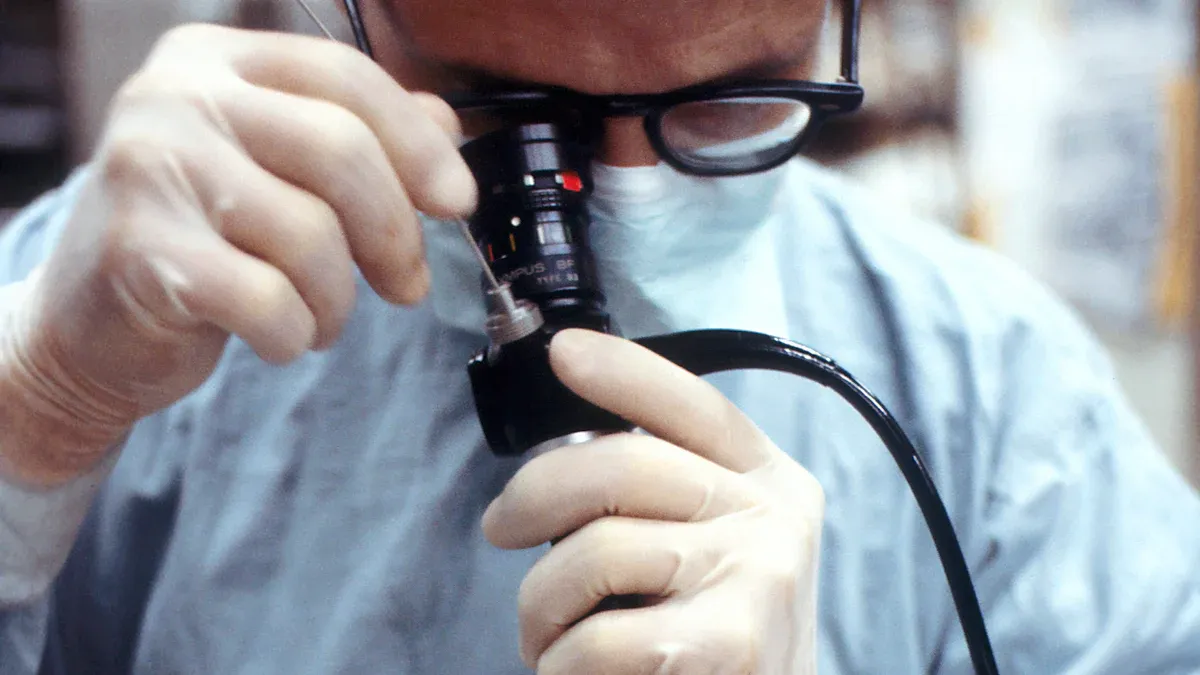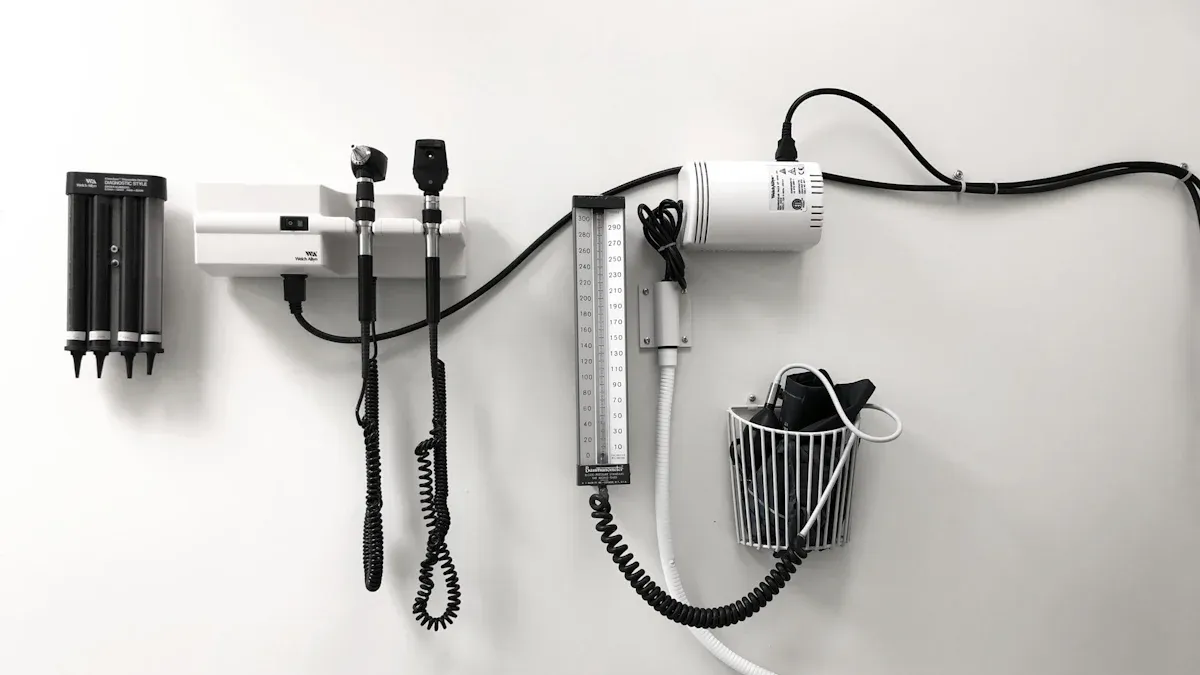How to Improve Kink Resistance in Nitinol Tubing for Medical Devices

Kink resistance is crucial for Nitinol tubing kink resistance solutions in medical tools. If the tubing kinks, it can obstruct fluid flow or compromise the device's integrity. This poses risks for both patients and doctors. Kinking typically occurs when the tubing bends or is subjected to pressure. Addressing this issue is essential during the design and manufacturing of the tubing. Enhanced kink resistance ensures that the tubing endures longer and operates more effectively. It also maintains the safety and reliability of devices in challenging medical scenarios.
Key Takeaways
Kink resistance is important for medical tubing to keep fluids moving and devices working, protecting patients and doctors from harm.
Nitinol is a special material that bends easily and returns to shape, making it great for tubing that resists kinks in medical tools.
Choosing the right materials, heating them correctly, and treating the surface can make Nitinol tubing stronger and last longer.
Adding materials like steel or nylon can make tubing tougher and bendable, helping it work better in medical uses.
Testing and checking quality are needed to make sure Nitinol tubing is strong, kink-resistant, and works well.
Understanding Kink-Resistant Tubing

What is kink resistance in medical tubing?
Kink resistance means tubing stays strong and works when bent. Medical tubing often needs to fit into tight spaces or bend around body parts. Without good kink resistance, tubing can fold or collapse. This can block fluid flow or stop devices from working. Kink resistance helps tubing stay flexible and tough, even in hard situations.
Strong kink-resistant tubing avoids problems in important medical tasks. For example, tubing with nylon threads is stronger and doesn’t kink. This is very important for tools like catheters or infusion systems. By keeping its shape, kink-resistant tubing works well in many medical uses.
Why is kink resistance important in medical tools?
Kink resistance keeps medical devices safe and working properly. Tubing in healthcare deals with body movements and pressure changes. If tubing kinks, it can stop fluid flow or break devices. For example, spinal-fluid shunts need steady flow to avoid problems. Pacemakers also need tubing that won’t crush to keep working.
Kink-resistant tubing is great for devices used long-term. These devices must work even when patients move a lot. In wound therapy, tubing must not collapse under pressure to help healing. Kink-resistant tubing solves these issues, making medical devices more reliable.
How does nitinol help with kink resistance?
Nitinol is a mix of nickel and titanium used in tubing. It bends a lot without breaking and remembers its shape. These features make nitinol perfect for kink-resistant tubing. Alloys with less energy loss resist kinks better. The energy lost during bending shows how well tubing performs.
Nitinol is both strong and flexible, which is useful in medical tools. It handles bending and twisting in curved paths, like guidewires. But making nitinol tubing needs careful work to avoid problems. Issues like tiny cracks or wear must be fixed for quality. Even with challenges, nitinol is key for kink-resistant tubing in advanced medical devices.
Key Factors Influencing Kink Resistance
Material composition and superelasticity
Nitinol's material mix affects how well it resists kinks. Nitinol, made of nickel and titanium, stays flexible under stress. Its bending behavior depends on its transformation temperature. This temperature changes with the nickel-to-titanium ratio. Even small changes can affect how it works.
Experts use a test called Differential Scanning Calorimetry (DSC). This test checks the transformation temperature to ensure good performance. Another test, "bend free recovery," measures how tubing returns to shape after bending. Superelastic nitinol, with an Active Af temperature just below room temperature, resists kinks well. These alloys bend easily but stay strong, making them great for medical tools.
Tubing dimensions and wall thickness
The size of nitinol tubing affects its kink resistance. Thin walls bend easily but might collapse under pressure. Thick walls are stronger but less flexible. A balance between wall thickness and diameter is important.
For example, small tubes with thick walls work well under high pressure. But they may not bend enough for some uses. Choosing the right size depends on how the tubing will be used. This ensures it bends and handles pressure without breaking.
Impact of manufacturing processes and surface treatments
How tubing is made affects its kink resistance. Careful production keeps quality consistent. Laser cutting and heat treatment improve flexibility and strength. Heat treatment also stabilizes the material, helping it handle stress better.
Surface treatments are also important. Polishing and coating remove flaws that weaken tubing. Smooth surfaces help tubing bend evenly without collapsing. Using advanced methods and treatments creates tubing with excellent kink resistance.
Environmental and operational conditions
Environmental and working conditions affect how well nitinol tubing resists kinks. It’s important to think about these factors to make sure the tubing works well in medical devices.
Temperature Changes
Temperature shifts can change how flexible and strong nitinol tubing is. Very cold temperatures might make it less stretchy. High heat could make it weaker. Always test the tubing in the temperatures it will face. This helps it keep its shape and avoid kinking, even in tough conditions.
Moisture and Humidity
Water and humidity can harm the surface of nitinol tubing. Long exposure to wet conditions might cause rust or surface damage. To stop this, use coatings or treatments that protect the tubing from wear.
Tip: Pick nitinol tubing with coatings made for its specific environment. This keeps it lasting longer and working better.
Stress from Use
Medical devices often bend, twist, or press on tubing repeatedly. Over time, this can weaken the tubing and make it kink more easily. Test the tubing under similar conditions to see if it can handle the stress.
Chemical Contact
Some chemicals, like cleaners or body fluids, can affect nitinol tubing. These can change its properties or damage its surface. Choose tubing that works well with the chemicals it will meet.
Important Tips for Chemical Safety:
Test tubing with common cleaning products.
Make sure it works with fluids like blood or saline.
By managing these environmental and working factors, you can make nitinol tubing stronger against kinks and more dependable in medical tools.
Nitinol Tubing Kink Resistance Solutions
Picking the right material and using heat treatment
Choosing good materials and using heat treatment helps tubing resist kinks. Nitinol alloys with superelastic features are great for bending without breaking. Adjusting the mix of nickel and titanium makes tubing stronger under stress.
Heat treatment makes tubing more flexible and durable. Controlling heat and time during treatment reduces stress inside the tubing. This helps it return to its shape after bending. For medical tools, proper heat treatment ensures tubing works well in tough situations.
Improving tubing design with braiding or coiling
Braiding and coiling make tubing stronger against kinks. Braiding wraps thin wires around tubing for extra support. This design boosts strength and helps in surgeries needing small tools. Working with wire makers improves braiding quality and tubing performance.
Braiding can have problems like tangles or breaks. Fixing these needs careful control of wire size and winding. When done right, braided tubing bends easily and stays strong for medical use.
Coiling spreads stress evenly across tubing. Coiled designs let tubing bend smoothly without folding. This makes them perfect for uses needing lots of flexibility. Adding these designs helps tubing handle bending and twisting better.
Adding reinforcement materials like steel or nylon
Reinforcement materials make tubing even tougher against kinks. Stainless steel adds strength and lasts a long time. Steel wires or mesh inside tubing stop it from folding under pressure.
Nylon is also a good choice for reinforcement. It keeps tubing flexible but strong. Nylon threads inside tubing create a lightweight but sturdy design. Mixing nitinol with these materials makes tubing both strong and bendable.
Reinforcements protect tubing from damage like scratches or holes. Adding these materials makes tubing last longer and work better in hard conditions.
Advanced Manufacturing and Quality Control Practices
Making nitinol tubing stronger against kinks needs careful manufacturing. Using precise methods and strict testing ensures it works well in medical tools. Below are ways to make nitinol tubing better and more reliable.
Precision Manufacturing Techniques
Special manufacturing methods help nitinol tubing stay strong and flexible. Here are some useful techniques:
Laser Cutting: This method creates detailed designs on the tubing. It makes the tubing bendable but still strong. It also reduces waste, making it efficient.
Electrochemical Machining (ECM): ECM removes material without causing heat or stress damage. It creates smooth edges and avoids tiny cracks that can weaken the tubing.
3D Printing: This method builds tubing layer by layer with great accuracy. It allows for custom designs to fit specific medical needs.
Tip: Pick a method that matches the tubing's purpose. For example, laser cutting is good for guidewires, while ECM works for delicate tasks.
Surface Treatments for Better Performance
Surface treatments make nitinol tubing last longer and resist kinks better. These treatments fix flaws and help the tubing handle stress. Common treatments include:
Polishing: This smooths out rough spots, making the tubing less likely to kink. It also lowers friction, which is helpful for tools like catheters.
Coating: Adding protective layers shields the tubing from moisture and chemicals. Coatings also make the tubing safer for the body.
Passivation: This chemical process cleans the surface and makes it stronger. It helps prevent rust, which is important for long-term use.
Strict Quality Control Checks
Quality checks make sure every piece of tubing meets high standards. Careful testing finds and fixes problems early. Key checks include:
Dimensional Inspection: Tools measure the tubing’s size to ensure even walls and diameter. This is important for kink resistance.
Bend Testing: This test checks if the tubing bends without folding. It mimics real-life use to see how it performs under pressure.
Fatigue Testing: This test bends and twists the tubing repeatedly. It ensures the tubing can last a long time in medical devices.
Note: Keep records of all tests to spot trends and improve quality.
Using Automation and Smart Tools
Adding automation and smart tools makes manufacturing faster and better. Examples include:
Robots: Robots do repetitive jobs with great accuracy, reducing mistakes.
Machine Learning: AI studies production data to find problems early. This helps fix issues before they get worse.
Real-Time Monitoring: Sensors check conditions during production. This allows quick adjustments to keep quality steady.
By mixing advanced methods with strict checks, you can make nitinol tubing that resists kinks and works well in medical tools. These steps improve performance and keep patients safe and happy.
Benefits of Kink-Resistant Tubing in Medical Devices

Better device reliability and performance
Kink-resistant tubing helps medical devices work better and last longer. Nitinol tubing is strong and works well in tough conditions. It can handle bending and twisting without breaking, making it great for long-term use. Devices like guidewires use nitinol's superelasticity to move through tricky paths without kinking.
Key features of reliable tubing include:
Durability: It stays strong after lots of use.
Fatigue Resistance: It works even after repeated bending.
Kink Resistance: It bends without folding or collapsing.
These features make kink-resistant tubing essential for dependable medical tools.
Improved patient safety and comfort
Kink-resistant tubing helps keep patients safe during medical procedures. It ensures smooth fluid flow and keeps devices working properly. This lowers the chance of problems during treatments. For example, in catheters, kink resistance stops blockages that could harm patients.
This tubing also makes procedures more comfortable. Its smooth bending reduces pressure on tissues, causing less pain. Patients recover faster and feel better when devices work as they should.
Tip: Pick tubing made for your specific medical needs to improve safety and comfort.
More uses for nitinol-based medical tools
Kink-resistant tubing allows for new ideas in medical devices. Nitinol tubing is flexible and strong, making it perfect for many tools. From guidewires to stents, it works well under stress and supports creative designs.
It’s also great for minimally invasive surgeries. Its flexibility helps it move through tight spaces, making it ideal for advanced tools. As technology improves, kink-resistant tubing will help create even more innovative medical devices.
Kink resistance is important for keeping medical devices safe and reliable. Tubing that doesn’t kink allows fluids to flow smoothly and keeps devices working properly. This feature should be a top priority when designing and making medical tools.
To make tubing resist kinks, focus on key things like the materials used, the size of the tubing, and how it’s made. Techniques like heat treatment, adding strong materials, and polishing the surface can help tubing handle bending without breaking.
Tip: Kink-resistant tubing helps both makers and users. It makes devices work better, keeps patients more comfortable, and allows for new medical ideas. Choosing high-quality tubing leads to better results for everyone.
FAQ
Why is nitinol tubing good for medical tools?
Nitinol tubing is strong and bends easily. It can bend without breaking because of its superelasticity. Its shape memory helps it return to its original form. These features make it great for medical devices needing strength and accuracy.
How do you check kink resistance in nitinol tubing?
You can test it by bending and stressing the tubing. Bend tests see if the tubing bends without folding. Fatigue tests check how it handles repeated bending. These tests make sure the tubing works well for medical use.
Can the environment change how nitinol tubing works?
Yes, things like heat, water, and chemicals can affect it. Very hot or cold temperatures can change its flexibility. Water or chemicals might harm its surface. Coatings and testing help protect the tubing in tough conditions.
Why does heat treatment help with kink resistance?
Heat treatment makes tubing stronger and more flexible. It lowers stress inside the tubing, so it bends better. This process helps the tubing work well in hard medical situations.
How do reinforcement materials improve tubing?
Materials like steel or nylon make tubing tougher. They stop it from folding under pressure but keep it bendable. This makes the tubing last longer and work better for medical devices.
Tip: Pick reinforcement materials that match your device’s needs.

